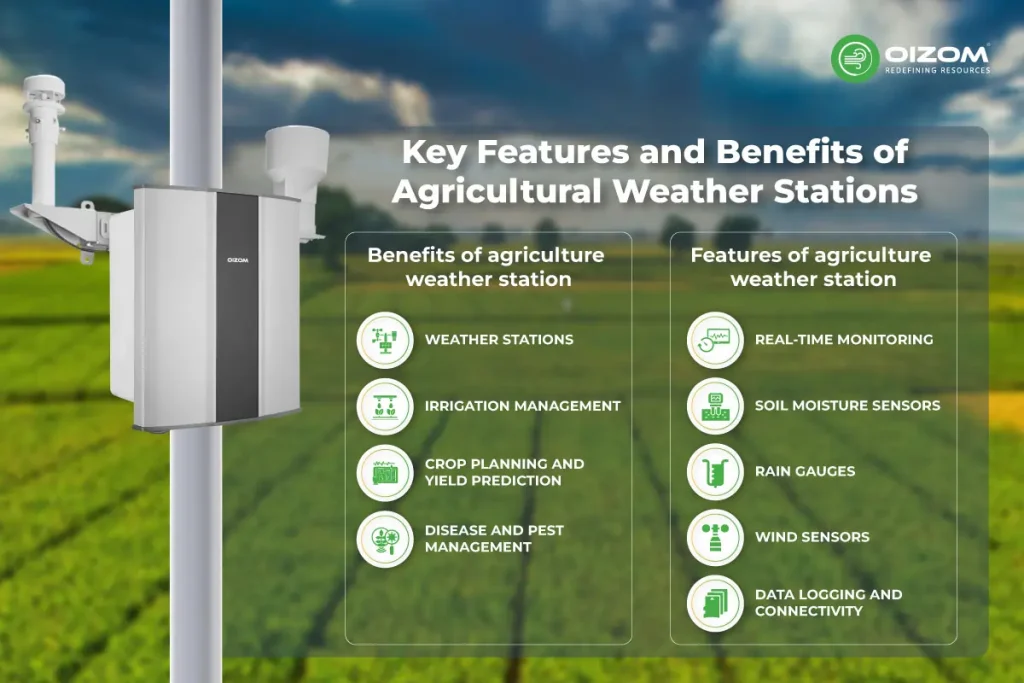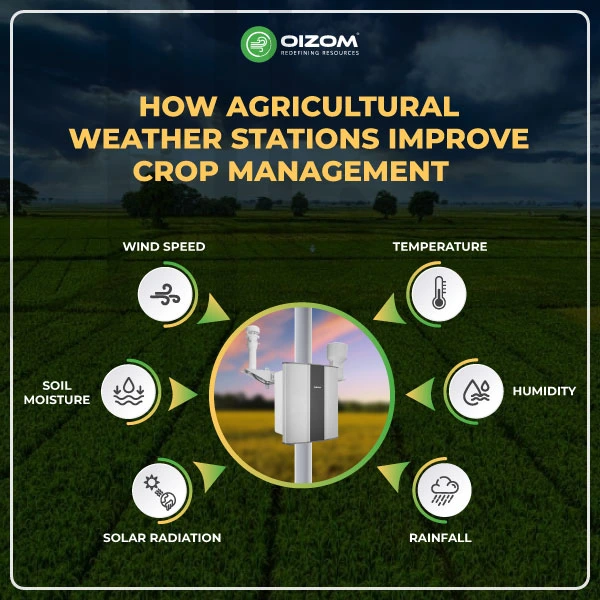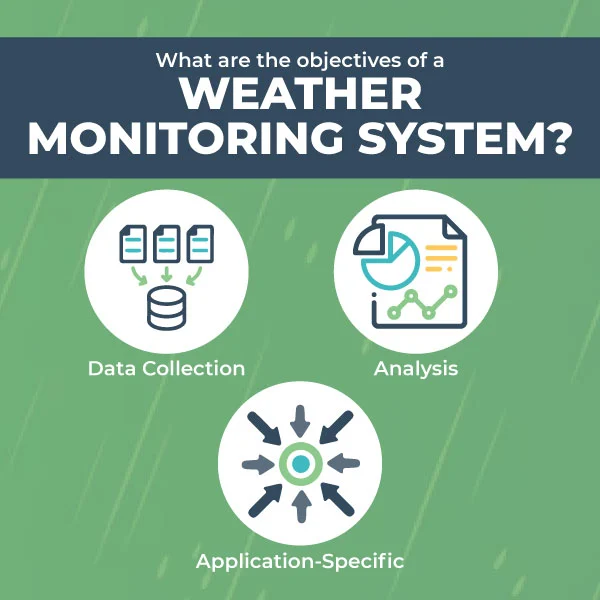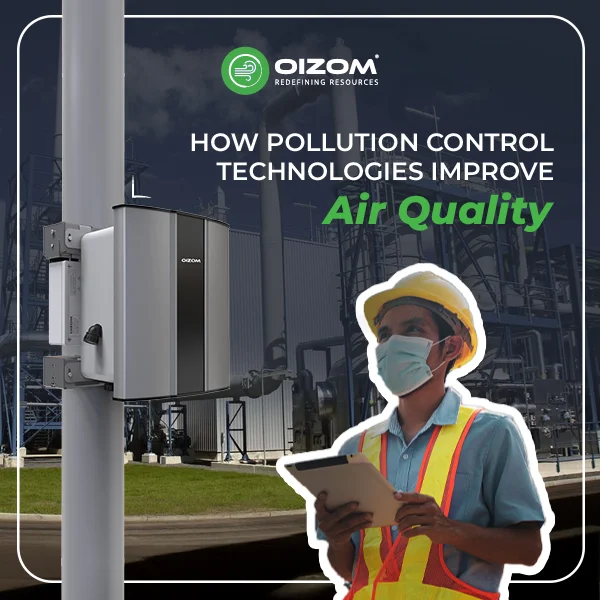10 key takeaway points:
- Essential Tool: Agricultural weather stations provide real-time data to improve farm management and productivity.
- Key Parameters: They monitor temperature, humidity, rainfall, wind speed, solar radiation, and soil moisture.
- Precision Farming: These stations enable smarter decisions about irrigation, pest control, and planting schedules.
- Disease and Pest Management: By analyzing environmental data, farmers can prevent or mitigate disease outbreaks and pest infestations.
- Irrigation Optimization: Soil moisture sensors help conserve water and avoid over-irrigation, improving crop health.
- Disaster Prevention: Weather stations predict and warn against agricultural risks like droughts, floods, and freezes.
- Data-Driven Decisions: Farmers can access analyzed data in easy-to-understand formats like charts and graphs.
- Applications: Useful for production, research, disaster management, and agricultural insurance support.
- Oizom Weathercom: A reliable, advanced weather station with robust sensors and real-time connectivity for precise farming.
- Sustainability: Investing in weather stations supports efficient resource use and long-term agricultural success.
How Agricultural Weather Stations Improve Crop Management
Agricultural weather stations are essential tools designed to help farmers and agronomists monitor environmental conditions directly in the field. These advanced systems collect real-time data on key parameters such as temperature, humidity, rainfall, wind speed, soil moisture, and solar radiation. By providing accurate, localized weather insights, they allow users to make informed decisions about irrigation, pest control, planting, and harvesting schedules.
Think of an agricultural weather station as your on-site weather expert, working around the clock to ensure optimal crop health and resource efficiency. Unlike generic weather forecasts, these stations deliver hyper-local data modified to the specific needs of your farm. Whether you’re managing a small orchard or a large-scale agricultural operation, this technology helps reduce risks, improve yields, and optimize resources.
With the growing need for accurate farming, agricultural weather stations are key to sustainable and efficient farming practices. Are you curious to know how they work and how they can transform your farming outcomes? Let’s dive deeper!
Why Are Agricultural Weather Stations Important?
Agricultural weather stations are designed to give precise and dependable meteorological data for agricultural production and assist farmers and agricultural practitioners in understanding climate change and farmland meteorology.
Agricultural weather stations play a vital role in modern farming by providing real-time, accurate environmental data. They help farmers monitor key conditions like temperature, humidity, rainfall, wind, and soil moisture, which are critical for making informed decisions. Imagine knowing exactly when to water your crops, protect them from frost, or adjust your planting schedule, all thanks to precise weather insights.
Are you worried about how to measure soil moisture at your agriculture site? Don’t worry; with Oizom Weathercom, you don’t need to stress. It provides accurate soil moisture data, so you always know what your crops need. By understanding local weather patterns, they can avoid over-irrigation, reduce pest-related losses, and even plan for extreme weather events.
Key Features and Benefits of Agricultural Weather Stations

There are various features and benefits of agricultural weather stations, which are listed below:
- Weather stations: weather stations monitor various meteorological factors, including temperature, humidity, wind speed and direction, precipitation, solar radiation, and atmospheric pressure. Accurate and up-to-date weather data is critical for understanding local climatic patterns, forecasting weather changes, and managing farm activities effectively.
- Irrigation Management: Weather stations assist farmers in optimizing irrigation techniques by giving data on evapotranspiration (ET), which is the combined loss of water through evaporation from the soil surface and transpiration from plants. Farmers can use ET rates to calculate when and how much water to apply, resulting in more effective water use and less waste.
- Crop Planning and Yield Prediction: Farmers can use historical weather data obtained by Outdoor weather stations to study long-term climatic trends, plan crop rotations, and forecast potential yield outcomes. Understanding the relationship between weather patterns and agricultural performance allows farmers to make more educated decisions about crop selection, planting dates, and other management strategies.
- Disease and Pest Management: Certain meteorological conditions promote the spread of plant diseases and pests. Weather stations give data that farmers can use to measure the prevalence of certain situations, such as excessive humidity or temperature inversions. This allows for quick interventions to prevent or minimize disease outbreaks and pest infestations.
Features of agriculture weather station:
- Real-Time Monitoring: These stations provide live updates on essential weather parameters like temperature, humidity, rainfall, wind speed, and solar radiation, keeping you informed around the clock.
- Soil Moisture Sensors: They measure soil moisture levels accurately, helping optimize irrigation and conserve water.
- Rain Gauges: Track rainfall precisely to plan watering schedules and avoid over-irrigation.
- Wind Sensors: Monitor wind speed and direction to protect crops from potential damage.
- Data Logging and Connectivity: Many stations store data and connect via IoT, allowing remote access to your farm’s conditions through a smartphone or computer.
Applications of Agricultural Weather Stations
Weather stations are used almost everywhere in agriculture.
- First and foremost, weather stations provide critical data assistance for agricultural productivity. Farmers, for example, may gain an accurate view of their irrigation needs by monitoring soil moisture in real time, allowing them to optimize water use while improving crop yields and quality.
- Furthermore, weather station data on temperature, humidity, light, and wind speed can help farmers understand the environmental conditions in which their crops grow, providing a scientific foundation for adjusting planting strategies, increasing yields, and optimizing planting time.
- Weather stations play an important part in agricultural studies, as well. Researchers can collect a vast amount of meteorological data from weather stations and undertake in-depth data analysis and scientific research, such as examining the influence of climate change on agriculture or weighing the benefits and drawbacks of various planting schemes.
- Weather stations also play a significant role in agricultural disaster prevention and management. Weather stations can expect and warn of potential agricultural catastrophes, such as droughts, floods, low-temperature freezes, and so on, allowing farmers to take proactive actions to minimize and mitigate the impact of disasters on agriculture.
- Guiding irrigation: Farmers can determine when to irrigate their farmland based on soil moisture data provided by weather stations. If the soil is too dry, it is time to irrigate to ensure that crops receive the water they require.
- Agricultural insurance: Agricultural weather stations can give precise weather data, which can be used to support agricultural insurance claims. When a disaster occurs, weather station data can be used to show the disaster’s existence and severity, assisting farmers in obtaining greater insurance reimbursement.
Overall, the application of weather stations in the field of agriculture covers a variety of aspects such as production, scientific research, insurance, etc., which plays an important role in improving the efficiency of agricultural production, safeguarding the interests of farmers and promoting the sustainable development of agriculture.
Working Mechanism of weather stations at agriculture
The working principle of an agricultural weather station revolves around four simple steps:
- Data Collection: Sensors placed strategically in the field/or in-built devices gather real-time data on key weather and soil parameters, ensuring accurate and representative measurements.
- Data Processing: This raw data is processed by a built-in data logger or transmitted to a central system. Smart algorithms analyze it to create actionable insights.
- Data Interpretation: The analyzed data helps farmers understand its impact on crop health, irrigation needs, disease prevention, and overall farm management.
- Data Presentation: The insights are displayed as easy-to-read charts, graphs, or reports, enabling farmers and researchers to make quick, informed decisions.
If you are searching for a reliable and advanced solution, Oizom Weathercom has covered you. This innovative tool makes managing your farm’s weather and soil data effortless. With robust sensors, real-time connectivity, and a design built to last, it’s the perfect partner for accurate farming. Oizom Weathercom helps you make smarter decisions, optimize resources, and focus on what truly matters: growing healthy, productive crops.
Conclusion
In conclusion, agricultural weather stations are invaluable tools for modern farming, offering real-time insights to monitor weather conditions, optimize irrigation, manage pests, and plan crop activities effectively. These specialized systems collect and analyze key environmental parameters like temperature, humidity, rainfall, wind, solar radiation, and soil moisture, empowering farmers to make informed decisions. By choosing the right weather station, considering sensor accuracy, data connectivity, weather station software, and maintenance needs, farmers can improve productivity, enhance resource efficiency, and adopt sustainable practices. Investing in a reliable weather station is not just a step toward better farm management but also a pathway to increased yields and long-term agricultural success.






